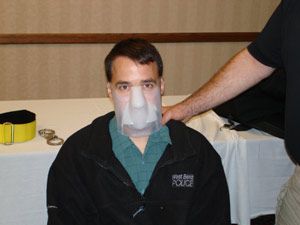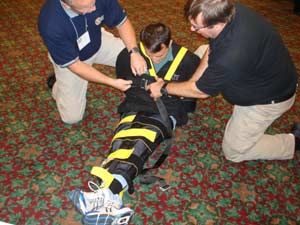Q: What is the best way to extract an uncooperative/assaultive suspect from the backseat of a squad car?
A: There is no easy answer for how to get a non-compliant/resisting/assaultive prisoner out of the back of a vehicle. I assume that the prisoner is restrained with his hands handcuffed behind the back, or in front but attached to the body with some sort of transport belt. The best restraint system would have the prisoner’s feet also restrained, or at least held together with some sort of leg restraints. (This is an assumption because the prisoner may not be restrained or may have escaped from his restraints by slipping them, picking them, or breaking them.) The bottom line is that you have a prisoner who, for all practical purposes, is like an animal backed into his cave who is very dangerous — unless the prisoner is in a full restraint like the WRAP Restraint. If not, you need to be ready to rock ‘n’ roll.
Since you are going to have to place your hands, arms, and other body parts into the prisoner “cave,” the better equipped you are and the safer you will be. I remember one violent subject who came into our jail from another facility who was met by a fully suited CERT Team complete with riot gear, helmets, protective (gas) masks, stab resistant gloves with a full complement of restraint equipment including a RIPP Restraint Backboard with accompanying spit net and gurney. Things went very well because we were completely covered and protected from blunt trauma, and the helmets and protective (gas) masks protected us from him spitting or throwing fluids on our faces.
After negotiations failed, we opened the door, waited for the kicks, dragged him out of the van to the awaiting restraint backboard that was standing by on the gurney. He was dragged out, secured to the backboard, fitted with a sit net, and moved out without comment moving toward our maximum security section. The neatest thing about the whole event was the shocked looks on the street officers’ faces who were standing by. They were waiting for a massive cluster and all they got was poetry in motion. I loved it. However, the unfortunate truth is that most facilities don’t have this type of fully outfitted teams standing by with the proper equipment and training to pull this off.
What can you do? First of all, wait the prisoner out if you can. Keep talking and try to wear him down. Many times, proper Tactical Communication Skills can stop the resistance and generate voluntary compliance so physical force is not needed. If this is possible, get a team together and use come sort of Control Device like a TASER or OC Spray, if available to overcome resistance prior to entering the prisoner’s “cave.”
An impact weapon can also be used, if necessary, to overcome the kicks or punches that are sure to come — but you still need a team standing by with restraints and commercial anti-spitting devices. (Using sheets or blankets for this purpose can come back to bite you as we have learned by bitter experience.) Once you stop the initial assault by control devices or impact weapons, the team should quickly but safely remove the prisoner from the vehicle and stabilize the prisoner’s arms, legs, and head while applying restraints and an anti-spitting device. The STAR Tactic works very well for this purpose and can now be viewed on the training section of the new Police1 www.BLUtube.com.
The long and the short of it is, getting a non-compliant prisoner out of a car is never an easy proposition but the more ready you are for this event, the smoother it will go. It should be noted that not only the street officers standing by in the example a related above were shocked by our response. The prisoner was taken aback, as well. He did struggle a bit, but only a bit. It kind of takes the fun out of the fight when you, as the prisoner, are facing insurmountable odds by a staff that views your resistance as a minor distraction and not a battle to the death. It’s humiliating. As we rolled the prisoner through the facility, everyone saw that the inmate had fought the law and the law had won. A good lesson for everyone — the staff and the inmate population.
Q: What about getting them into a squad car?
A: Although the issues are similar, getting them into a squad is slightly different. Getting them out of the squad is often damage control.(The prisoner is already in the squad and now we have to figure out how to get an out of control, potentially violent prisoner out.) On the other hand, at the point that you are deciding to put a prisoner in your squad, you still have options for yours and their safety. You can add special restraints to immobilize the prisoner if the prisoner should decide to continue to be violent or get violent later. You can decide that a medical transport, i.e. ambulance, is a better option because it saves on wear and tear on the squad upholstery, doors, and windows. Or, you can decide that due to the prisoner’s current medical condition, a ride in the squad is a bad idea – don’t transport unconscious or semi-conscious prisoners in your squad. Medical transportation is designed to keep a sick or injured subject, as safe and secure as possible. Sick or injured prisoners belong is an ambulance, not a squad.
At some point, a decision may be made to transport the prisoner by squad. Remember if the hands are restrained to the body, the danger is from kicks, head butts, bites, and spitting. Stay away from these attacks.
Kicking prisoner sitting in the back seat of a squad
 |
Remember that if you fight someone into the squad, you may well have to fight them out. Avoid the fight, if possible, by diffusing the subject’s anger while immobilizing their ability to attack you and/or injure themselves.
1. Talk them into the squad, if possible. (See the Police1 Columns by Dr. George Thompson including “Talking the Talk of Peace: The Peace Warrior.”)
2. Remember to prevent spitting, if possible, with a commercial spit net. Improvised spit nets often can work, i.e., will do the job but may come back to “bite” you later – no pun intended. Use commercial ones designed for this purpose.
RIPP Restraint Protection Mask
 |
3. If uncooperative/combative, consider special restraints such a Safe Restraints WRAP Restraint or RIPP Restraint Sit Belt with Hobble System.
Safe Restraints WRAP Restraint
 |
RIPP Restraint Sit Belt with Hobble System
 |
4. If this is not possible, consider transporting them by ambulance. Remember if someone can’t or won’t walk to the squad, they may require alternate transportation, e.g., an ambulance with a gurney and/or RIPP Restraint Backboard System.
RIPP Restraint Back Board
 |
Conclusion
Why put an uncooperative/assaultive prisoner who has not been immobilized into a squad car, where they can injure officers or themselves while busting up the squad. . .and who will probably continue to be uncooperative/assaultive when officers have to take him out of the squad at the jail. Don’t make a mistake that could get officers, as well as the prisoner, injured while generating millions of dollars in liability exposure. Don’t make a $500.00 mistake. Transporting a prisoner by ambulance and/or purchasing the necessary special restraints are a very cost effective alternative to expensive squad repairs and accompanying criminal and civil liability.
For more information about WRAP Restraints see www.saferestraints.com
For more information about RIPP Restraints see www.ripprestraints.com


